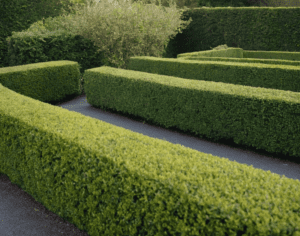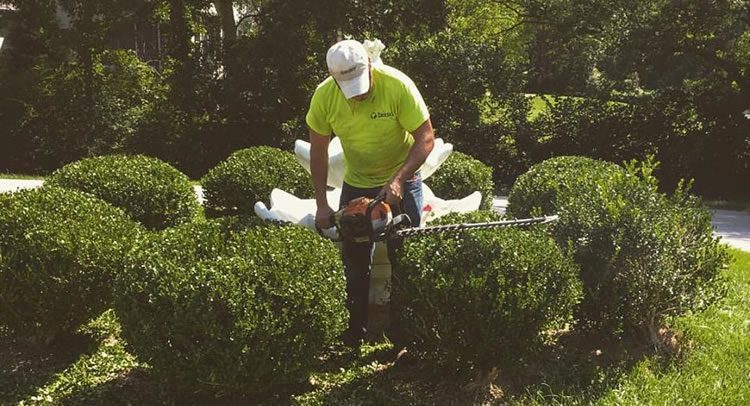Hedges are a fantastic way to add privacy, structure, and beauty to your garden. But keeping them looking their best requires regular trimming. We will take you through everything you need to know about hedge trimming, from when to trim different types of hedges to achieving the perfect shape.
Why Trim Your Hedges?
Regular hedge trimming offers several benefits:
- Maintains Shape and Size: Trimming keeps your hedges neat and tidy, preventing them from becoming overgrown and blocking walkways or sunlight.
- Encourages New Growth: Trimming stimulates new growth, resulting in a thicker, healthier hedge.
- Improves Airflow and Light Penetration: Regular trimming allows air and light to reach all parts of the hedge, promoting overall health.
When to Trim Different Hedges
The best time to trim a hedge depends on the type of plant.
Here’s a general guide:
- Evergreen Hedges: Trim most evergreens like yew, holly, and box in late spring (May-June) and again in late summer (August).
- Deciduous Hedges: Flowering hedges like viburnum and honeysuckle can be trimmed after flowering (May-June). Others, like beech and hornbeam, are best trimmed in late summer (July-August) or early fall (September).
How to Trim Your Hedges
Tools you’ll need:
- Hedge shears (for small hedges and shaping)
- Long-reach hedge trimmers (for larger hedges)
- Pruning gloves
- Safety glasses
- String line (for creating straight lines)
Steps:
- Plan your shape: Decide on the desired shape for your hedge. Formal hedges typically have straight sides and a flat top, while informal hedges can be rounded or curved.
- Prepare your tools: Sharpen your shears and ensure your hedge trimmers are charged or have a full gas tank.
- Set up a guide (optional): For a straight line, tie a string line between two posts at the desired height.
- Start trimming: Begin at the bottom of the hedge and work your way up. Cut with a sawing motion, staying slightly behind the guide string if using one.
- Maintain a level base: Cut the sides of the hedge slightly narrower at the top than the bottom. This allows sunlight to reach the lower branches and prevents the hedge from becoming bare at the base.
- Clean up: After trimming, remove clippings from the base of the hedge and dispose of them properly.
Shaping Your Hedges

Hedges can be trimmed into shapes, such as formal squares, rounded balls (topiary), or informal slopes. More complex shapes require more frequent trimming and may best suit experienced gardeners.
Types of Hedge Shapes:
Formal squares: Geometrically precise, with sharp angles and straight lines.
Rounded balls (topiary): Spherical or conical shapes, often used to create intricate designs or sculptures.
Informal slopes: Naturalistic and asymmetrical, with uneven contours and varying heights.
Trimming Requirements:
Formal squares: Require frequent and precise trimming to maintain their shape.
Rounded balls: Also demand regular trimming, but the frequency can vary depending on the desired size and complexity.
Informal slopes: Require less frequent trimming, as their irregular nature allows for some variation in height and shape.
Suitability for Gardeners:
Formal squares and rounded balls: Best suited for experienced gardeners with the skills and time to maintain their intricate shapes.
Informal slopes: These are more feasible for novice gardeners who may not have the expertise or time for frequent trimming.
Renovating Old Hedges
Overgrown hedges can be rejuvenated with a more drastic cutback. For severely overgrown hedges, consider hiring a professional. Here are some tips for reviving a neglected hedge:
- Identify the type of hedge: Different hedge varieties respond differently to pruning.
- Make a significant initial cut: Cut back overgrown hedges by up to one-third of their height and width. This will stimulate new growth.
- Follow up with regular trimming: Once new growth appears, trim regularly to maintain the desired shape and encourage further thickening.
Safety Tips
- Always wear gloves, eye protection, and long pants when trimming hedges.
- Be aware of your surroundings and watch out for electrical wires, fences, or other obstacles.
- Use a sturdy ladder for tall hedges and avoid overextending yourself.
- Never cut through thick branches that could damage your tools or cause kickback.
Frequently Asked Questions (FAQ)
-
Q: Can I trim hedges in the fall?
While some hedges can be trimmed in early fall, it’s generally best to avoid extensive trimming in late fall or winter as it can damage new growth.
-
Q: How often should I trim my hedge?
The frequency depends on the type of hedge. Formal hedges may need trimming 2-3 times a year, while informal hedges might only need one annual trim.
-
Q: What should I do with hedge clippings?
You can add small clippings to your compost pile (shred larger ones first). Alternatively, use them as mulch around your plants.
Happy Hedging!
Following these tips lets you keep your hedges healthy and looking their best throughout the year. Remember, proper trimming encourages healthy growth and adds beauty and structure to your garden.
Conclusion on Hedge trimming for your Garden
- When pruning or trimming mature hedges, the thickest branches should probably be taken out first to help promote more significant growth.
- In areas with ice and snowfall, it’s recommended to make rounded tops on shrubs and hedges to stop them from accumulating, which can harm internal branches.
- When pruning evergreens. Larger, individual stems must be cut off first.
- Evergreens with narrow leaves should be pruned when they’re young, as this can result in controlled and enhanced health growth.
- Evergreens with broad leaves don’t require care that is much. They are okay to go numerous seasons without significant trimming. If a considerable amount of older wood is removed, it can impair new growth. Aim to do small but often.
- Manual shears are very simple to deal with, making trimming internal branches a cinch. Use these to eliminate weighty components before finishing with a durable and powerful hedge trimmer.
- Start from the bottom part and make your way up. Overgrown hedges can deal with extensive trim, but be careful not to sever the primary branches that nourish the top.
- If likely, trim hedges in mid-morning. This is once the dew has evaporated and the atmosphere has limited moisture. If not possible, the goal is for the late afternoon.
- Hedge trimming for your Garden is also good for your health.























